Prototypes
Origins
Development of IntelliBlinds™ began in the early 1990's, with the goal of filling a long-recognized market gap: the absence of a cost-effective Dynamic Daylight Control (DDC) technology for non-residential applications. The challenge was to slash the cost of DDC by 90% relative to conventional technology, while also making it easier to manufacture, distribute, and operate. Overcoming this challenge took over ten years of focused effort and resulted in three major IntelliBlinds™ design evolutions.
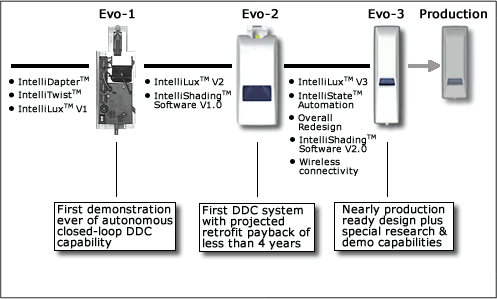
IntelliBlinds™ Evolution 1
When development of IntelliBlinds™ began, the state-of-the-art for high-performance DDC was to couple motorized shading, dimmable lighting, various sensors, and a control computer into an integrated dynamic daylighting system. Initially, IntelliBlinds™ development pursued the same integrated architecture.
Our approach was to throughly analyze the costs of integrated dynamic daylighting in order to identify any opportunities for major savings—even at the expense of some compromise in performance, if necessary. This was in contrast to the approach taken by most other researchers, who were developing sophisticated systems to explore the upper limits of the energy savings achievable through daylighting.
The first major cost reduction was achieved via development of IntelliDapter™, a retrofittable external motorization technology that could be used to instantly and quickly automate any of the more than 500 million miniblinds already installed in the U.S. (70 million of which are in non-residential buildings). The second major cost reduction was achieved via development of IntelliTwist™, an innovative user interface to eliminate the need for a conventional display and keypad.

However, while substantial, the cost savings enabled by these two patented innovations were still not enough to make integrated DDC cost-effective for daylighting retrofits. Eventually, we concluded that the only way to achieve this goal would be to develop an autonomous DDC technology that doesn't require integration with lighting or other building systems.
We needed another breakthrough to achieve this: the patented IntelliLux™ sensor technology. IntelliLux™ is an illumination sensor that discriminates between artificial and natural illumination. An autonomous shading system equipped with IntelliLux™ knows exactly how much daylight and how much artificial light is in the room—with no need for connections to the lighting system.
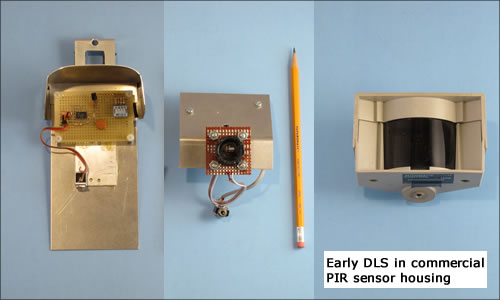
With the development of IntelliLux™, we had all the enabling technologies necessary to prototype the first practical, fully autonomous DDC system for daylighting applications: the IntelliBlinds™ Evo-1.
The Evo-1 design integrated the early IntelliDapter™, IntelliTwist™, and IntelliLux™ technologies with a microcontroller and a solar-charged battery supply to yield a simple, self-contained device that could be quickly retrofitted to any miniblind.
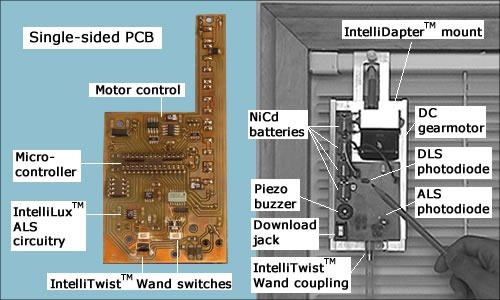
In 1998, the Evo-1 provided the first-ever demonstration of a fully autonomous, closed-loop DDC capability for daylighting applications. Its performance exceeded our expectations, validating the basic IntelliBlinds™ concept and justifying further development.
IntelliBlinds™ Evolution 2
While Evo-1 worked well, testing quickly revealed opportunities for improvement in the IntelliLux™ sensor and the daylight regulation algorithm. This prompted fabrication and testing of several new IntelliLux™ breadboards, as well as evaluation of numerous new daylight-regulation algorithms via a new system breadboard.
Evo-1 testing also convinced us to defer further use of a solar-charged supply until the technology becomes more cost-effective, and to shift from an EEPROM-based to a Flash-based microcontroller to facilitate rapid prototyping of new algorithms and software. And, to fully exploit the new microcontroller's substantially greater processing power, we also decided to develop a modular IntelliShading™ software suite to further facilitate development and testing of new capabilities.
The result of these improvements was the IntelliBlind Evo-2A:
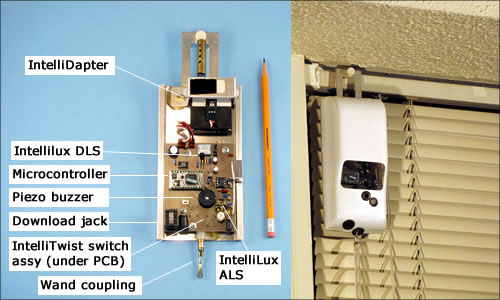
We fabricated a half-dozen Evo-2A units and tested them in the lab as well as in occupied buildings.
As expected, the Evo-2A performed better than the Evo-1: it did a better job of keeping the perceived daylight level at the desired set-point with lower risk of glare. As a result, average daylight levels were higher, yielding a shorter projected payback period. In fact, in 2001, the Evo-2A became the first-ever DDC system with a projected average payback period of less than 5 years in retrofit daylighting applications (assuming a unit cost based on high-volume production).
The Evo-2A also offered a more refined user interface, yielding a better user experience. In fact, our testers expressed interest in a similar device for use in their own homes. For this reason—and because we had already been investigating possible applications of the IntelliBlinds™ technologies for the residential market—we developed a residential variant, the Evo-2B.
The Evo-2B used a monolithic IR receiver (to provide IR remote control capability) instead of the IntelliLux™ DLS, but was otherwise identical to the Evo-2A.
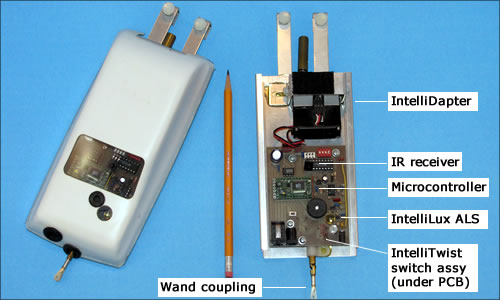
We built a half-dozen Evo-2Bs in 2002 and installed them in two residential buildings. They were univerally liked by the users, some of whom expressed disappointment when the test program was concluded.
Testing of the Evo-2As and 2Bs fully validated the IntelliBlinds™ technology and basic design. However, our assessment was that the market of the early 2000's was not yet ready for a product like IntelliBlinds™. While we waited for the market to come around, the Evo-2s remained in operation, collecting useful data for over a decade.
IntelliBlinds™ Evolution 3
As with the Evo-1, testing of the Evo-2s identified opportunities for major improvements in multiple areas, including:
- Electromechanical design
- Overall packaging
- IntelliLux™ sensor design
- Daylight control algorithm
- User interface
In addition, the testing—particularly with the Evo-2B residential units—had revealed interesting data about peoples' shading preferences under various conditions. This data stimulated development of what would eventually become the IntelliState™ Automation algorithm, which enables an automated shading system to actually learn and anticipate users' shading preferences without need for any deliberate programming.
We fabricated new technology breadboards to test the hardware improvements, and two new system breadboards—the Evo-3A and 3B—to integrate the hardware and develop the new algorithms and software. In addition to a more powerful microcontroller with larger memory, the Evo-3 system breadboards included an RF transceiver so that we could develop IntelliShading™ software extensions to support wireless remote control and downloads.
The Evo-3A system breadboard was up and running in early 2010, with the 3B coming online in mid 2012. The testing indicated a 33% decrease in projected payback period relative to the Evo-2 design (due to increased average daylight level stemming from improvements in the IntelliLux™ sensor and the DDC algorithms).
Our plan was to run the Evo-3 system breadboards for three months to collect useful data in the lab, and then design and fabricate a new Evo-3 IntelliBlinds™ prototype for testing outside the lab. However, the volume of useful data from the breadboards remained heavy even after several months of testing, prompting us to defer the "design freeze" for the new prototype until 2Q 2014. The design is now frozen, and fabrication of the new Evo-3 units are underway.
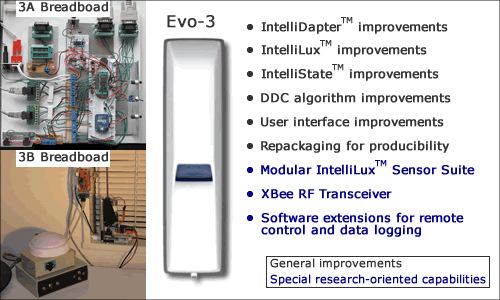
In addition to providing the capabilities, look-and-feel, and most of the design features of the envisioned production unit, the Evo-3 prototype will also include special research and demonstration capabilities that will probably be omitted (for cost reasons) from the production units:
- Like the Evo-3 system breadboards, the Evo-3 prototype will include hardware and software to enable remote control, performance monitoring, and environmental data collection via a wireless link. For example, the Evo-3 will be able to wirelessly send the exterior and interior daylight levels, the slat tilt angle, and the artificial lighting level (among many other variables) to a remote PC upon request. These capabilities will facilitate IntelliBlinds™ testing and demonstrations, as well as real-world daylighting research in occupied buildings.
- The Evo-3 will have a replaceable IntelliLux™ sensor assembly, which will allow us to rapidly demonstrate new IntelliLux™ designs in the field.
With its RF remote control capability, Evo-3 could also be used to emulate a future residential version of IntelliBlinds™, and we expect to use it for that purpose after commercialization of the non-residential version is underway.
Future Prototypes
Given Evo-3's functionality and flexibility, we don't anticipate the need for a fourth generation functional prototype in the near future. There are several innovations in the pipeline, but all of these can be tested and demonstrated in the Evo-3.
Further, IntelliBlinds™ is now ready for commercialization, so the next step would be a pre-production prototype of the product that would actually enter the market.
Summary of Key Points
- Development of IntelliBlinds™ began in the early 1990's and has spanned three major design evolutions
- In 1998, the Evo-1 provided the first-ever demonstration of a fully autonomous, closed-loop DDC capability for daylighting applications.
- In 2001, the Evo-2A became the first-ever DDC system with a projected average payback period of less than 4 years in daylighting retrofits.
- In 2002, the Evo-2B successfully demonstrated a residential version of the IntelliBlinds™ design.
- In 2010, the Evo-3A system breadboard was used to develop and demonstrate v2.0 of the IntelliShading software, including patented IntelliState™ automation. Thanks to improvments in the IntelliLux™ sensors and the DDC algorithms, testing with the Evo-3A and 3B breadboards showed a 33% decrease in projected payback period relative to the Evo-2 design.
- The Evo-3 prototype, currently entering in fabrication, incorporates numerous improvements in performance and producibility relative to Evo-2, and provides a superset of the capabilities of the envisioned production unit
- No additional functional prototypes are envisioned beyond Evo-3: IntelliBlinds™ is now ready for commercialization, and the next step would be a pre-production prototype of the product that will actually enter the distribution pipeline

